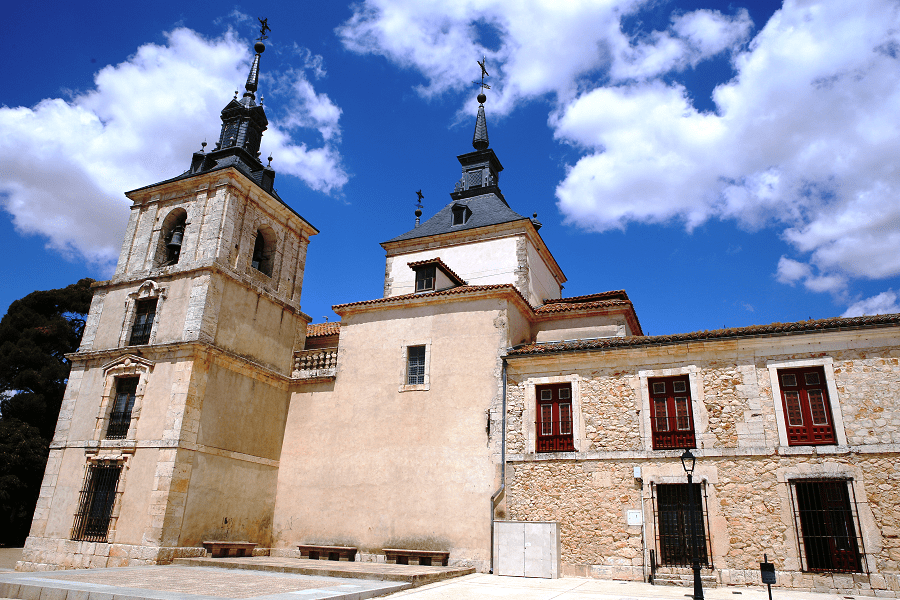Nuevo Baztán is a municipality belonging to the Community of Madrid (Spain) located in the Cuenca del Henares region, located 50 km east of Madrid.
The historic center has its beginnings in the period from 1709 to 1713 as the residence of the workers of a glass factory founded ex novo by Juan de Goyeneche y Gastón (follower of French rationalism).
The name of Nuevo Baztán comes from the Baztán valley, in Navarra, the birthplace of Juan de Goyeneche. The urban model of streets in an orthogonal grid defined at the beginning of the 18th century for this town has been the object of study by Spanish urban planners such as Fernando Chueca Goitia: «Example of traditional baroque urbanism». Goyeneche commissioned the design of the buildings and its urban spatial distribution to the Spanish architect José Benito Churriguera.
The town occupies a place on the plateau, where there used to be a holly forest (Ilex aquifolium). The industries were operating until the middle of the 18th century, undergoing various transformations until they were definitively closed, the old town remained in a state of abandonment for several centuries.
At the beginning of the 20th century, various attempts were made to restore the old town, and in 1941 it was declared a Historic-Artistic Monument. In 1965, at the initiative of an urban development company, the expansion of the old town was promoted with the urbanization of Eurovillas, later other developments were built that made the population grow in its periphery.
Since March 16, 2000, the complex formed by the Goyeneche palace and the church (dedicated to the Navarrese saint Francisco Javier) has been considered an Asset of Cultural Interest.
Main attractions
The Goyeneche Palace is an eighteenth-century palace with a linked church. It was designed by José de Churriguera, an architect known for a profusely decorated style known as Churrigueresque. The church’s interior is an example of this baroque style, whereas the exterior is less ornate.
The building is one of a number of palaces in Spain and Peru which are associated with the Goyeneche family. Nuevo Baztán was built as a model village by Juan de Goyeneche (1656–1735) to accommodate industrial and agricultural projects.
The dedication of the church to Saint Francis Xavier reflects the Navarrese origins of the Goyeneche family.
There have been proposals to restore the palace for use as an art gallery, although the project appears to have been put on hold. The idea was a collaboration between the Community of Madrid and the art-collector Carmen Thyssen-Bornemisza who indicated her willingness to display items from her private collection on long-term loan.
The palace has extensive cellars built for storage purposes and these are used to house an interpretation centre. There are also guided tours of the palace itself.
The church of San Francisco Javier is adjacent to the Goyeneche Palace, both designed by the architect José Benito Churriguera and built between 1709 and 1713. The church received the declaration of Historic Artistic Monument in 1941, along with the Goyeneche Palace, annexed to the building, and the two squares located in the front and rear. In 2000 the monumental complex was classified as a Site of Cultural Interest by the Community of Madrid.
The church is consecrated to San Francisco Javier, co-patron of Navarra. Its main façade is made up of a portal and two towers, 27.5 m high, flanking each side and doubling the height of the palace. They are topped by slate roofs with four slopes, which recall the spiers of the Herrerian style, due to the shape of their arrows, crowned with weather vanes.
Plazas
Currently there are the following spaces:
Plaza de la Iglesia, also called Plaza del Jardín or Plaza Mayor. It extends in front of the main facade of the palace-church, which, as mentioned, faces west. It has a quadrangular plan and, at its central point, is the Fountain of the Tritons, so named because it has three ichthyocentaurs as an ornament on its spike.
Plaza de las Fiestas, also known as the bullring, because bullfighting celebrations were held there. It is rectangular in shape. It is located next to the rear facade of the palace-church, which forms the western face of the enclosure. Its northern and eastern sides are delimited by the Houses of Trades, whose façade, in this part, is formed by a balcony with arches.
Market Square. It is located to the south of the central nucleus and once fulfilled a commercial function. After its construction, a fountain was added.
La Campa. This is how the old palace garden is known. Only different groves are preserved.
How to get to?
From Madrid 55 min (52.3 km) via R-3
From Gaudalajara 44 min (54.7 km) via A-2
Main information
Area: 20 sq. km
GPS coordinates: 40°21′53″N 3°14′36″W
Language: Spanish
Population: 6454
Currency: Euro
Visa: Schengen
Time: Central European UTC +1, in summer +2

















